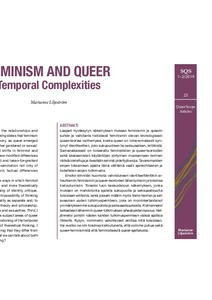FEMINISM AND QUEER : Temporal Complexities
Liljeström Marianne
https://urn.fi/URN:NBN:fi-fe2021042822993
Tiivistelmä
A widely recognised view concerning the relationships and
exchange between feminist and queer thinking states that feminism
is chronologically “older” than queer theory, as queer emerged
precisely as a critique of identities, whether gendered or sexual.
Simultaneously, it has been noted that shifts in feminist and
queer theories and academic practices have modified differences
between the two in terms of both alleged and taken-for-granted
dissimilarities. This claim requires an examination not only of
customary variances, but also of current, factual differences
between these theories.
In this article, first I pay attention to the ways in which feminist
and queer theories have become closer and more theoretically
intermixed together with the strengthening of identity critique.
Second, I connect this discussion to the impossibility of thinking
about the categories of gender and sexuality as separate and, to
some extent, to the establishing of trans theory and scholarship,
multiplying our understandings of genders and sexualities. Third, I
take a closer look at the broadening of the subject areas of queer
scholarship. Fourth, this leads me to a questioning of the temporal
movements between these two strands of theoretical thinking. I
ask, how are we today convincingly showing that they differ from
each other? Or, are they so intertwined that we can talk about both
queer feminism and feminist queer thinking?
Kokoelmat
- Rinnakkaistallenteet [19207]
